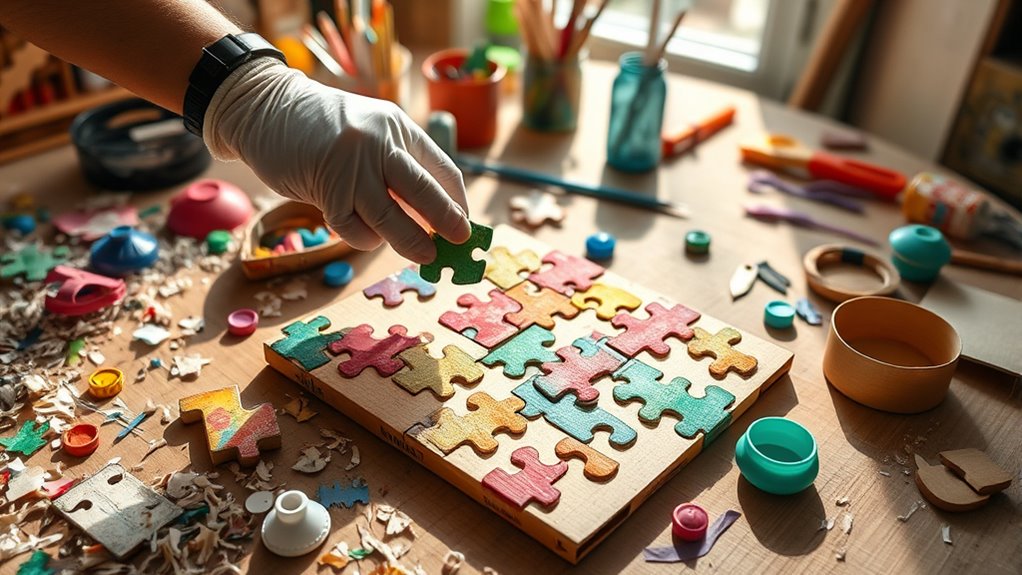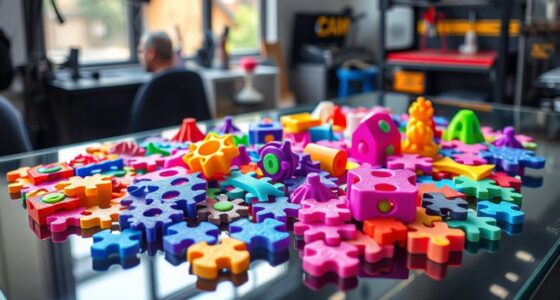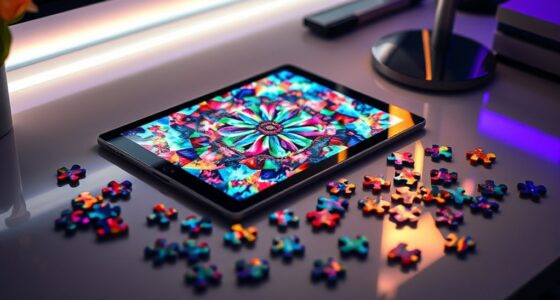To make puzzles from recycled materials, gather items like cardboard, paper, or plastic, and clean them thoroughly. Use eco-friendly adhesives to bond layers or attach cut-out images from magazines or old books for vibrant visuals. Cut your designs with sharp tools, experimenting with shapes for uniqueness, and reinforce the pieces for durability. This process reflects your commitment to sustainability while creating fun, artistic puzzles. Keep exploring to discover creative tips and techniques to enhance your project.
Key Takeaways
- Select and prepare recycled materials like cardboard, paper, or plastic for puzzle creation.
- Use eco-friendly adhesives to assemble and bond pieces securely.
- Incorporate varied textures, images, or materials for engaging, creative puzzle designs.
- Cut puzzle pieces with sharp tools, experimenting with shapes for uniqueness and durability.
- Promote sustainability by reusing materials and choosing environmentally conscious crafting methods.

Creating puzzles from recycled materials is an excellent way to combine creativity with environmental responsibility. When you choose to repurpose items like cardboard, paper, or plastic, you’re giving new life to materials that might otherwise end up in a landfill. This approach not only reduces waste but also sparks your imagination as you design unique, eco-friendly puzzles. To guarantee your puzzle stays durable and safe, using eco friendly adhesives is essential. These adhesives are made from natural or non-toxic ingredients, making them a responsible choice for both your project and the environment. They provide a strong bond without the harmful chemicals found in conventional glues, guaranteeing your puzzle remains intact without compromising your eco-conscious values.
Repurpose materials and use eco-friendly adhesives to create durable, environmentally responsible puzzles.
As you start creating, experimenting with different creative design techniques will help you craft visually appealing and engaging puzzles. For example, you can layer recycled paper to add texture or incorporate vibrant images from magazines and old books, cutting them into puzzle pieces. Using creative design techniques also means thinking outside the box—consider mixing materials like fabric scraps or metal pieces into your puzzle for added dimension. With a keen eye for detail, you can create intricate patterns or thematic scenes that make your puzzle more mesmerizing. Take your time selecting colors and images to make sure each piece contributes to the overall aesthetic, making the puzzle not just a fun activity but also a piece of art. Additionally, understanding the importance of sustainability can guide you in choosing eco-friendly materials and practices for your project.
When it comes to cutting your puzzle pieces, using sharp tools and precise techniques will give you clean, professional edges. You might want to experiment with different shapes or irregular edges to add a unique touch that sets your puzzle apart. Remember, the key is to be patient and meticulous, ensuring each piece fits perfectly with its neighbors. If you’re working with thicker recycled materials, consider reinforcing the pieces with additional layers or coatings to prevent wear over time. This extra step helps your puzzle withstand repeated use, keeping it enjoyable for years to come.
Throughout the process, always keep sustainability in mind by reusing materials and selecting eco friendly adhesives. The combination of creative design techniques and environmentally conscious choices results in a puzzle that’s not only fun to assemble but also reflects your commitment to protecting the planet. Making puzzles from recycled materials isn’t just a craft; it’s an opportunity to promote sustainability while expressing your artistic side. Every piece you create becomes a proof to your ingenuity and dedication to reducing waste—evidence that with a little effort, you can turn everyday items into something beautiful and meaningful.
Frequently Asked Questions
What Are the Best Recycled Materials for Puzzle-Making?
You should use recycled paper and cardboard of high quality for puzzle-making. Recycled paper provides a smooth surface for clear images, while sturdy cardboard offers durability. Look for thick, tightly pressed recycled cardboard to guarantee your puzzles hold together well during use. Avoid flimsy materials, and choose recycled paper with minimal ink or coatings for the best results. This way, your puzzles are eco-friendly and long-lasting.
How Can I Ensure Recycled Puzzles Are Durable?
Want your recycled puzzles to last? You should use eco-friendly adhesives that provide a strong bond without harming the environment. Sealing the surface with protective coatings or surface sealing techniques also enhances durability. Have you considered applying a clear sealant to prevent wear and tear? These steps guarantee your puzzles are sturdy, eco-conscious, and enjoyable for years to come.
Are Recycled Puzzles Suitable for Children?
Recycled puzzles are suitable for children as long as you prioritize child safety and choose age-appropriate designs. They offer educational benefits by encouraging problem-solving, cognitive skills, and environmental awareness. Guarantee the recycled materials are non-toxic and sturdy to withstand handling. Supervise young children during play to prevent choking hazards and ensure safe use. With proper selection and supervision, recycled puzzles make engaging, eco-friendly, and educational toys for kids of all ages.
What Tools Are Needed to Make Recycled Puzzles?
To craft puzzle templates from recycled materials, you’ll need basic cutting tools for puzzles like a craft knife, scissors, and a cutting mat for safety. These tools help you accurately cut your recycled materials into puzzle pieces, ensuring clean, crisp edges. Using a ruler and pencil makes marking and measuring easier, while a glue or adhesive can help assemble your puzzle. With these tools, you can turn old materials into engaging, eco-friendly puzzles.
How Can I Decorate or Personalize Recycled Puzzles?
You can decorate or personalize recycled puzzles using creative decorative techniques like painting, adding stickers, or using decoupage for unique designs. Personalization ideas include writing messages with markers, attaching photos, or incorporating textured elements. Experiment with different colors and patterns to make your puzzle truly one-of-a-kind. This way, you turn a simple recycled puzzle into a meaningful, personalized piece that reflects your style and creativity.
Conclusion
By choosing recycled materials, you not only create unique puzzles but also help the environment. Imagine turning old cardboard boxes into colorful, challenging puzzles for kids or friends. For example, Sarah transformed scrap paper into beautiful puzzle pieces that brought her family together. With a little creativity, you can make fun, eco-friendly puzzles that make a difference. So, grab some recycled materials and start crafting your own sustainable puzzles today!









